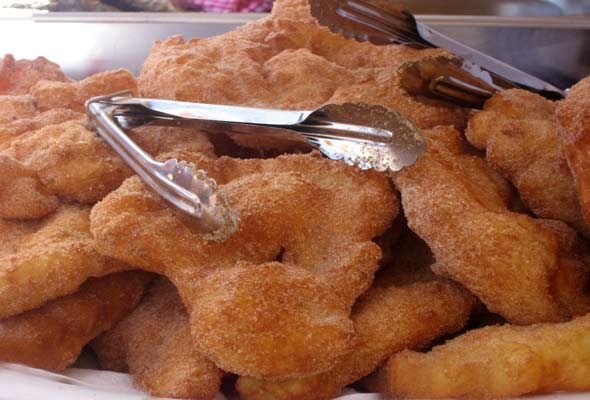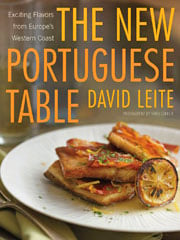
This recipe, adapted from the one my dad’s mom used to make in the Azores, has a flood of memories attached to it. I would sleep over at her house many a Friday night and on Saturdays she’d make these for my cousins, Fatima and Joe, and me. Hot out of the sugar-cinnamon bowl is the only way to eat them. In the Azores, some cooks shape these over their knees until they’re practically the size of lunch plates, just like my grandmother used to do. Others stretch and flop them out in their hands. I’ve made these smaller so they’re easier to work with, and fiddled with the recipe a touch, but beyond that, welcome to my childhood.–David Leite


Malassadas | Portuguese Doughnuts
Equipment
- Deep-fry or candy or instant-read thermometer
Ingredients
For the doughnuts | malassadas
- 1/2 cup whole milk
- 2 tablespoons unsalted butter, plus more for the bowl
- 3/4 teaspoon kosher salt
- 1 package active dry yeast, (2 1/4 teaspoons or 1/4 ounce)
- 1/3 cup plus 1 teaspoon granulated sugar
- 2 tablespoons warm water, 110°F (43°C)
- 3 large eggs
- 3 1/2 cups all-purpose flour, plus more for the work surface
- Nonstick cooking spray
- Vegetable oil, for frying
For the cinnamon sugar
- 1 cup granulated sugar
- 1/2 teaspoon ground cinnamon
Instructions
Make the doughnuts | malassadas
- Heat the milk, butter, and salt in a medium saucepan over medium-high heat, stirring frequently, until it just begins to steam and form bubbles around the edges, about 5 minutes. Remove from the heat and let cool until lukewarm.
- Meanwhile, in a small bowl, dissolve the yeast and 1 teaspoon sugar in the warm water. Let stand until foamy, about 10 minutes.
- In the bowl of a stand mixer fitted with the paddle attachment or with a hand mixer in a large bowl, beat the remaining 1/3 cup sugar and the eggs on medium-high until thick and luscious looking, about 5 minutes.
- Switch to the dough hook, add the milk mixture, the yeast mixture, and the flour, and mix on low speed until a soft dough forms, about 7 minutes, adding more flour if needed. The dough should be just slightly tacky but not sticky.
- Turn the dough onto a lightly floured work surface, shape into a ball, and place in a lightly buttered large bowl. Cover with plastic wrap and let rise in a warm, draft-free spot until double in size, about 2 hours.
- Lightly coat a 13-by-18-inch rimmed baking sheet with cooking spray and turn the dough onto the pan. Press and poke it with your fingers, much like making focaccia, to help stretch it until it's about 1/2 inch thick. Lightly coat the top of the dough with cooking spray, loosely cover the pan with plastic wrap, and let the dough rest at room temperature until double in size, 1 to 1 1/2 hours.
Make the cinnamon sugar
- Mix together the sugar and cinnamon in a shallow bowl.
Fry the doughnuts | malassadas
- Fill a medium saucepan with 3 inches of oil and heat over medium-high heat until it reaches 350°F (177°C) on a deep-fry or candy or instant-read thermometer. Monitor the heat to keep a steady temperature.
- Using scissors or your hands, cut or pull a 2-to-3-inch piece of dough from the baking sheet and stretch it into a 4-to-5-inch circle, then lower it into the oil and fry, turning frequently, just until golden brown on both sides and cooked through, 45 seconds to 1 1/2 minutes, depending on the size. Drain the doughnut on paper towels for 30 seconds and then toss in the cinnamon sugar. Repeat with the remaining dough. Devour warm.

Nutrition
Nutrition information is automatically calculated, so should only be used as an approximation.
Recipe Testers’ Reviews
I think I have a love for Portuguese desserts because I seem to try my hand at a different Portuguese recipe every Valentine’s Day. This year, I made these malassadas, and they did not disappoint!
The dough came together exactly as the instructions say. My dough was tacky to the touch. I made a mistake with the first rise and only let it go 1 1/4 hours…ooops! I guess I was overly anxious to get these in my tummy and I miscalculated the 2-hour rise. Regardless of that fact, my dough did continue to double on the second rise and these were a cinch to fry and coat with sugar. I bet if I let the first rise complete the full 2 hours, my malassadas would have been slightly more puffy and airy, but these were still really delicious and enjoyed by the family.
I used olive oil to fry these and they weren’t oily at all. I coated a half batch with plain sugar and a half batch with cinnamon sugar. They were both great.
I plan on making these again. Thanks to David for sharing his childhood recipe!
















I’m curious–can you refrigerate the dough overnight?
Monica, I’ve never tried that with this dough. I’ve retarded dough rising in the refrigerator many times, so I think you probably can do it.
May I ask why you want to refrigerate overnight?
Thank you for this recipe. It has been my husband’s family tradition to gather to make malasadas together on Pancake Tuesday, when my mother-in-law would make enough dough for at least 100 or more delicious little pillows of yum. Because of health reasons, she can no longer cook so I am thrilled to be able to continue this family tradition like their Vavo used to for my kids. Like many Portuguese moms, writing down family recipes was not her strong suit and following the “two fingers of this & one of her favorite tea mugs of something else” just doesn’t work. Thank you again!
Rebecca
Rebecca, I’m so thrilled to hear this. It’s stories like yours that make all the work we do worth it. Eat well, enjoy your family, e por favor dê o meu melhor para sua sogra.
The best I have ever made Malassadas!! Thank you for your recipe!! ❤
You’re welcome, Marlene. We’re so pleased that you love it!
This makes my heart sing, Marlene. My grandmother is smiling in heaven!
I’m cooking for myself and I hate wasting food. Can the recipe be scaled down further? Thanks.
David, if you want to cut this down, I’d suggest using the metric amounts. It will be more accurate.
Thanks, David. I guess what I was asking is if I were to use one cup of flour and one egg or two cups of flour and 2 eggs would I keep the same quantities of the other ingredients. Thanks.
David, I see. You would have to reduce all the other ingredients proportionately. So if you cut the flour in half, all ingredients will have to be cut in half.
Thank you David – that makes sense. These look yummy and as I’ve never tried one before I have no reference point to judge if I’m even close to the real thing. The other thing, I suppose is to begin by following you recipe to a T, and then I’ll have an idea of what they taste like their and their consistency is before I start trying to reduce quantities. Thanks.
David, yes, I always think it’s best to try a recipe as-is the first time. Then you know what you’ve got and can adjust to your liking. Tell me how it turns out!